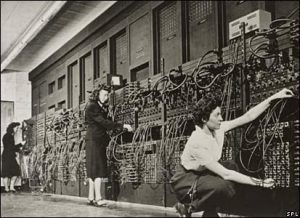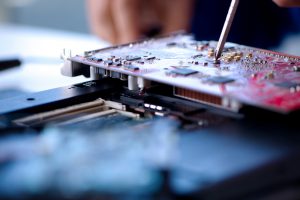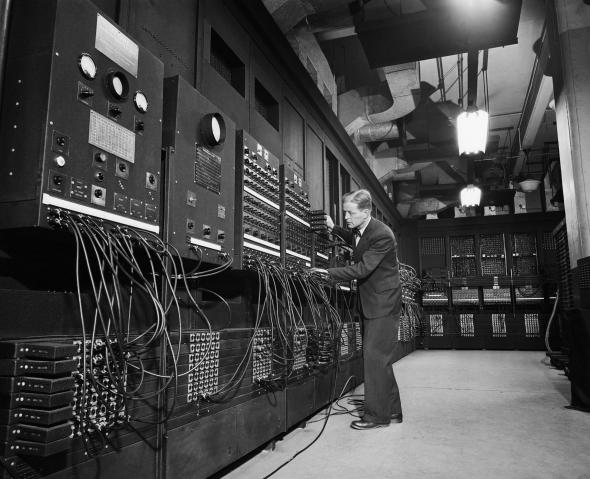How ENIAC, The World’s First Computer, Initiated and Influenced ITAD Processes
Procurri have long extolled the virtues of sustainable ITAD (IT Asset Disposition) processes – but of course, with computers and other electronic devices only having been mainstream possessions over the last 30 or so years, such services are fairly new. ITAD was initiated with the world’s first computer, and here, we tell the story of its development since.
ENIAC (an acronym for Electronic Numerical Integrator And Computer) took from 1943-1945 to create, when it was constructed for the US Army during the Second World War. It was built at the University of Pennsylvania with the intention of being able to calculate and analyse the trajectory of the enemies’ bombs and other projectiles; giving the Allies a strategic advantage.
The Size and Scope of ENIAC, the Earliest Computer
Needless to say, as expected for electronics made some 80 years ago, ENIAC was by no means a portable machine. It was housed in a room measuring 1,500 sq. ft, through 40 nine-foot cabinets containing 18,000 vacuum tubes, 1,500 relays and thousands of capacitors, inductors and resistors – and it weighed 30 tonnes!
Given its size, ENIAC’s physical operations were more akin to the data centers we see today than the laptops and PCs we’re used to. The vast heat generation from the machine mean that the room temperature frequently reached 120 degrees Fahrenheit, which had to be tempered by two 20-horsepower blowers to cool it. The machine used 160kW of energy, which today would still be enough to power industrial equipment and so back then was considered a big draw on the grid. Locally, rumours circulated that household lights dimmed and blackouts occurred throughout Philadelphia when ENIAC was turned on… but these remain anecdotal.
Indeed ENIAC was powerful, and certainly could compute considerably more than the human brains working hard behind the Allied operation. Trajectories could be calculated 2,400 times faster than it would take a human, and the US Army’s press secretary described it as “a new machine expected to revolutionize the mathematics of engineering”. Certainly, that it did.
However, as perhaps expected with such a vast technological leap, ENIAC’s development didn’t come without its challenges. With it taking so long to build, by the time it was completed World War 2 had nearly ended; and it had exceeded the Army’s initial $61,000 budget almost eight-fold. Come November 1946, ENIAC’s operations were ceased.
Updates and Upgrades Installed onto ENIAC
Rather than discontinue ENIAC entirely and scrap it (a move Procurri would of course not approve of!), the machine was refurbished and its memory upgraded. By July 1947, ENIAC was the fastest computer in the world and able to complete 5,000 calculations per second – a thousand times faster than the processing power of anything comparable. The team behind ENIAC then initiated a program of continuous improvement, administering upgrades and updates as often as possible to keep the machine fit for purpose and up and running. This was not yet the efficient update process we see today. One of ENIAC’s engineers, Herman Goldstine, explained the issue experienced as “The main difficulty was that this was not a stored program computer. Once we set it up to solve a problem it could do so very quickly. But every time we needed to change it we had to go back and reprogram it, which would take up to two days”.
ENIAC’s reprogramming was one of very few technical jobs made available to women during the Second World War – primarily because men were deployed elsewhere and in more frontline positions. Of the team of 200 women employed by the University of Pennsylvania during the war, six were designated entirely to the machine’s operations. When the war ended, most technical roles were returned to men, but the complexity of these jobs meant that they were unsuitable for retiring military personnel and so the women stayed employed thereafter to continue the work.
Further updates and upgrades continued, and in 1948, a converter unit was installed; allowing ENIAC to be programmed using standard IBM cards. This decreased the time needed for reprogramming from days to just hours and helped transform the computer to a multi-purpose machine.
The End of ENIAC’s Operations
ENIAC continued to be operational until October 1955, at which point it was physically destroyed beyond further refurbishment by a lightning strike. During its lifespan, it contributed toward the design of hydrogen bombs, fed into weather prediction, took part in cosmic-ray studies and was used to help design wind tunnels. By the time ENIAC finally ceased operations, it was thought that the computer had processed more calculations than the whole of humanity up until that time!
Of course, by the time ENIAC was finally decommissioned (albeit not through malfunction, but rather ‘an act of god’), computing was developing rapidly. By the end of 1950s integrated circuits and transistors installed in machines helped decrease the size and weight of them hugely, vastly reducing the physical parts needed to be refurbished, recycled, or ultimately, wasted.
ENIAC’s Legacy
ENIAC’s hardware was not recycled as such – not least because such processes simply didn’t exist when it was in operation. However, its continued refurbishment was a fantastic example of what has gone on form Third Party Maintenance services today: extending the lifecycle and inherent value in tech assets through their continued use rather than regular replacement.
As such an integral part of technological history, ENIAC’s legacy contributed not only to ITAD processes but also to the development of computers worldwide. In the 1970s, ENIAC’s tech patents were made public, which allowed anyone to develop and modify its designs. Such designs used in conjunction with a new breed of smaller, more powerful and more mainstream machines helped computing development soar and traces of ENIAC’s code can still be found in devices today. To celebrate the 50th anniversary of the machine, Pennsylvania University’s computing students created ‘ENIAC on a Chip and succeeded in placing the computer’s whole functionality onto a 7.44mm x 5.29mm chip.
Now rightfully considered an important historical artefact, part of ENIAC’s hardware is now on display at the Army headquarters where it was initially located. Unearthed, cleaned and painstakingly restored where it could be, a team commissioned by billionaire Robert Perot back in 2006 ensured it was accessible to the public: receiving the attention it deserves as a pinnacle of modern technology.
While now the power ENIAC enacted would equate to less than a common laptop, its importance in tech development should not be underestimated. Its 5,000 calculations per second could now be compared to an iPhone 6’s ability to 25-billion instructions per second, but without the former the latter likely would not have existed in the way it did today.
How ENIAC Impacts ITAD Now
‘Make do and mend’ was a popular mantra during World War 2 against a backdrop of material shortages and supply chain delays, but what was then adopted through necessity can now be done so with sustainability and longevity in mind. As the development of electronics has ramped up and the resulting accelerating change brings with it exponential growth vastly contradicting the intuitive linear view of most such advancements, tech’s own contribution to its development sees considerably more than a years’ worth of progress made for each year actually experienced.
This, alongside a societal culture of everyday ‘throw-away’ electronic devices and consumer overconsumption, means that if we’re to protect the natural environment within which this is all happening, we have to healthily negate the impact tech is having on the planet. ENIAC was a little slow on the uptake to be programmed and updated (at least, by today’s standards) but it has taught us a great amount of the importance of utilising what we already have to its maximum capacity in order to derive from it the best possible value.
Today, we can refurbish and recycle electronic parts of almost all devices to then reuse them either in other electronics or in a new consumer pathway. When hardware does eventually reach the end of its life – be that by lightning strike like ENIAC or more likely today, the replacement by smaller, more powerful parts – it can be processed for waste without having to reach landfill. Procurri works with only zero-to-landfill ITAD providers and adhere to the strict industry standards and regulations around not just physical hardware disposal but also data erasure, security and environmental impacts.
No matter how far we’ve come in tech development, one thing is for sure: the sector is set to keep on going. And so, at Procurri, we strive to support businesses in growing and innovating as best they can while supporting them in doing so in an environmentally friendly manner that will sustain not just the planet, but their business and industry as a whole. Sure, your individual computers are no longer as large as ENIAC in stature, but they could be in impact. And it’s exactly that Procurri wishes to protect.







